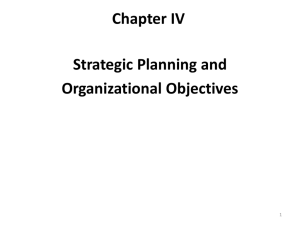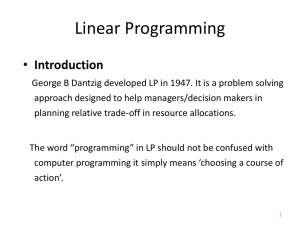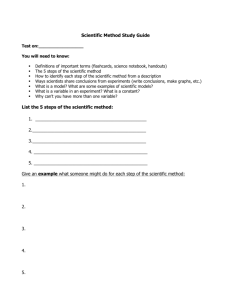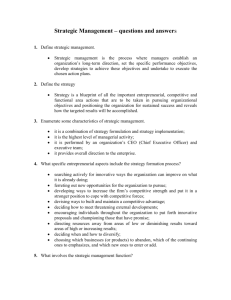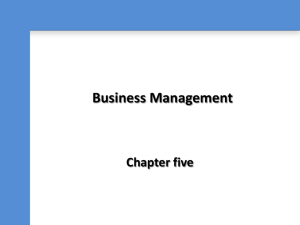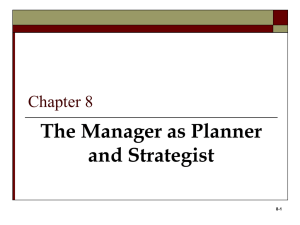Tools for Formulating Capital Market Expectations
advertisement
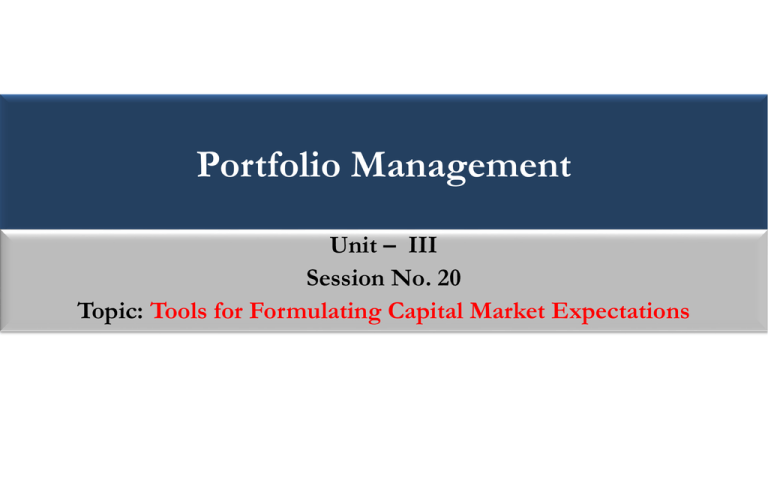
Portfolio Management Unit – III Session No. 20 Topic: Tools for Formulating Capital Market Expectations Session Plan • • • • Unit - III Briefing Capital Market Expectation Tools for Formulating Capital Market Expectations Summarizing and Q & A Tools for Formulating Capital Market Expectations • Different range of tools that have been used in professional forecasting of capital market returns. • Although an analyst may have distinct preferences among these approaches. • Different types of Tools are: – 1. Formal Tools – 2. Survey & Panel Method – 3. Judgment Method Tools for Formulating Capital Market Expectations • 1. Formal Tools • Formal tools are established research methods amenable to precise definition and independent replication of results. • The information data can help the analyst produce accurate forecasts. – Statistical Methods (Historical Statistical Approach: Sample Estimators, Shrinkage Estimators, Time-Series Estimators and Multifactor Models) – Discounted Cash Flow Models – The Risk Premium Approach – Financial Market Equilibrium Models Tools for Formulating Capital Market Expectations • Statistical Methods • Statistical methods relevant to expectations setting include descriptive statistics (methods for effectively summarizing data to describe important aspects of a dataset) and inferential statistics (methods for making estimates or forecasts about a larger group from a smaller group actually observed). • The simplest approach to forecasting is to use past data to directly forecast future outcomes of a variable of interest. • 1A. Historical Statistical Approach: Sample Estimators : – The sample arithmetic mean total return or sample geometric mean total return as an estimate of the expected return. – The sample variance as an estimate of the variance. – Sample correlations as estimates of correlations. Tools for Formulating Capital Market Expectations • Statistical Methods • 1B. Shrinkage Estimators Shrinkage estimation involves taking a weighted average of a historical estimate of a parameter. – the analyst’s relative belief in the estimates – This ‘‘two-estimates-are-better-than-one’’ approach has desirable statistical properties. • 1C. Time-Series Estimators Time-series estimators involve forecasting a variable on the basis of lagged values of the variable being forecast and often lagged values of other selected variables. – Time-series methods have been found useful in developing particularly short-term forecasts for financial and economic variables. Tools for Formulating Capital Market Expectations • Statistical Methods • 1D. Multifactor Models A multifactor model is a model that explains the returns to an asset in terms of the values of a set of return drivers or risk factors. Tools for Formulating Capital Market Expectations • 2. Discounted Cash Flow Models • Discounted cash flow models (DCF models) express the idea that an asset’s value is the present value of its (expected) cash flows. Formally, the value of an asset using a DCF approach is as follows: • 3. The Risk Premium Approach • The risk premium approach expresses the expected return on a risky asset as the sum of the risk-free rate of interest and one or more risk premiums that compensate investors for the risky asset’s exposure to sources of priced risk (risk for which investors demand compensation). Tools for Formulating Capital Market Expectations • 4. Financial Market Equilibrium Models • Financial equilibrium models describe relationships between expected return and risk in which supply and demand are in balance. • In that sense, equilibrium prices or equilibrium returns are fair if the equilibrium model is correct. Tools for Formulating Capital Market Expectations II. Survey and Panel Methods • The survey method of expectations setting involves asking a group of experts for their expectations and using the responses in capital market formulation. If the group queried and providing responses is fairly stable, the analyst in effect has a panel of experts and the approach can be called a panel method. • These approaches are based on the straightforward idea that a direct way to uncover a person’s expectations is to ask the person what they are. Tools for Formulating Capital Market Expectations III. Judgment • The analyst should be able to factually explain the basis and rationale for forecasts. • Quantitative models such as equilibrium models offer the prospect of providing a non-emotional, objective rationale for a forecast. • The expectations setting process nevertheless can give wide scope to applying judgment—in particular, economic and psychological insight—to improve forecasts. • In forecasting, numbers, including those produced by elaborate quantitative models, must be evaluated. • Other investors who rely on judgment in setting capital market expectations may discipline the process by the use of devices such as checklists. • In any case, investment experience, the study of capital markets, and intelligence are requisites for the development of judgment in setting capital market expectations.
